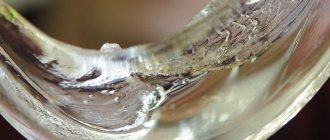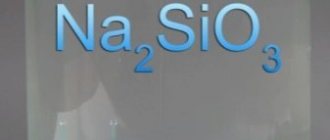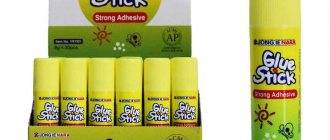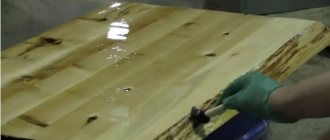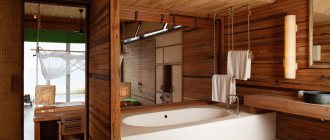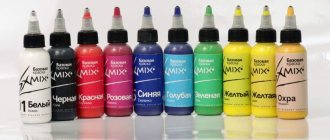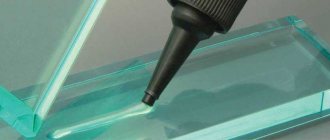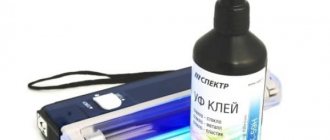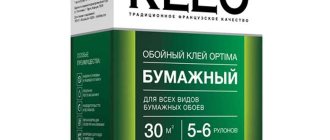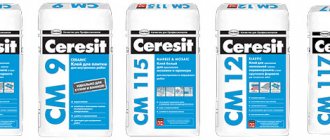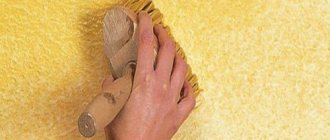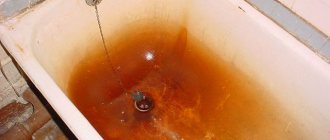Material characteristics
What is liquid glass? In scientific terms, this is a solution of sodium silicate and potassium silicate, that is, the building material in question contains the same components as ordinary glass. Another name for this material is silicate glue, which makes its use immediately clear.
Liquid glass has very high adhesive properties and is characterized by thermal conductivity - this material is often used in thermal insulation work. The insulation, in the manufacturing process of which liquid glass was used, can withstand temperatures of up to 1200 degrees Celsius!
Application of liquid glass
Liquid glass has found application in various fields of human activity, so it is impossible to quickly and compactly list all the aspects of its application. But there are areas that definitely need to be mentioned:
Liquid glass is used for waterproofing. Both the walls and the foundation are impregnated with this material - liquid glass turns such surfaces into ones that are not susceptible to moisture and changes in air temperature. It is advisable to use this material when insulating the walls of a house from the inside. Liquid glass is an excellent antiseptic.
You can often see fungus and mold on the walls and ceilings of residential premises, and indeed on various surfaces in general - these are the consequences of exposure to moisture. To get rid of this unpleasant and harmful phenomenon to human health, you need to use various means to destroy fungal colonies. If you treat a surface already damaged by mold/fungus with liquid glass, they will simply disappear.
For this purpose, liquid glass is used to prepare walls for wallpapering. Liquid glass has excellent adhesion. This means that it adheres perfectly to any surface. Using this material, you can glue completely different materials - from cardboard to porcelain. Liquid glass significantly increases the moisture resistance and fire safety of wood, paper and ceramics - they are specially coated with this product.
If we consider liquid glass exclusively from the construction side, then many mixtures can be made with this material. The material has found application in the following processes:
Primer with liquid glass.
Used for surface treatment before painting or wallpapering. Naturally, the option under consideration cannot be used in its pure form - it is simply mixed with cement in the following proportion: the same amount of liquid glass is taken for 10 kg of cement. First you need to mix cement with water, and then the resulting solution is poured into liquid glass. A solution for waterproofing work.
It is necessary to mix cement, sand and the material in question in equal proportions. The resulting mixture can be used for waterproofing work of any complexity. Fireproof solution. First, a cement-sand mixture is prepared - for 1 part of cement, take 3 parts of sifted sand.
Then a little liquid glass is added to the resulting mixture (about 20% of the total volume of the dry mixture). Use fireproof mortar with liquid glass for laying fireplaces and stoves. Protective agent against fungus and mold. It is necessary to dilute the material in question in water (proportions 1:1).
The resulting solution is used as an antiseptic for treating wooden, stone, plastered and other surfaces. Impregnation for processing materials during preparatory work. You will need to dilute 400 g of liquid glass in a liter of water and lubricate the surface two or three times. But keep in mind: each layer must be completely dry and only then can you begin to apply the next layer.
Liquid glass is a good option for high-quality furnishings (88 photos)
Liquid glass is widely used in construction. This is understandable, since it is moisture-resistant, wind-resistant, has excellent adhesion (adhesion to most surfaces) and chemical inertness, can serve as an antiseptic, is characterized by fire resistance, abrasion resistance, non-toxic, has low thermal conductivity, and is resistant to corrosion.
Liquid glass is rarely used in its pure form; most often it is used as an important component of many building materials.
Technology for producing liquid glass: a calcined mixture of quartz sand and soda is crushed and mixed with water.
Types of liquid glass
Based on the type of source materials, liquid glass can be:
- sodium;
- potassium;
- sodium-potassium;
- potassium - sodium;
- lithium
Potassium glass is indispensable in the production of enamel, and it is also an excellent binding component. In construction work, the most widely used type of liquid glass is sodium.
Methods of using liquid glass
Due to its water-repellent properties, liquid glass can be used as a waterproofing material.
Using liquid glass for waterproofing foundations
To create a reliable waterproof barrier, two layers of liquid glass must be applied to the foundation.
Each layer must dry completely. This kind of waterproofing is called coating; it requires the subsequent use of rolled waterproofing materials.
A mixture of cement mortar and sodium liquid glass can be used to qualitatively seal cracks formed in the foundation.
It can also be used in brick or concrete block masonry. For such a mixture, for 1 kg of cement you need to take 50 g of liquid glass and 750 g of water.
It is recommended to prepare a little solution at a time, as it tends to harden quickly.
Another method of waterproofing is to mix liquid glass with a concrete mixture, which is used to make a monolithic foundation.
The order of work is as follows: first, the formwork must be prepared and the reinforcement laid. Next, you need to prepare a mixture of sand and cement, then add liquid glass and crushed stone dissolved in water to it and immediately begin pouring the foundation.
The use of liquid glass for waterproofing pools and wells
Using liquid glass, you can carry out internal and external waterproofing work in the pool.
For internal waterproofing, first you need to treat all joints and recesses with glass, then you need to cover the floor and walls with it in 2 - 3 layers. For external waterproofing, liquid glass is added to the concrete mixture.
Waterproofing of wells is carried out using a mixture of cement-sand mortar with liquid glass, which first covers the surfaces of the seams and joints, and then the whole thing.
You can first apply a layer of liquid glass to the entire surface of the well.
Protecting basements from moisture using liquid glass
If moisture gets into the basement from leaky seams, proceed as follows:
We start by cleaning the seams, removing dust and various debris from them;
Mix Portland cement with liquid glass (in a ratio of 20 to 1), add the required amount of water - the repair mixture is ready;
Use the resulting mixture to fill every seam and every large crack;
Apply water with a brush to the coated surfaces;
Every other day we apply a layer of liquid glass.
Wet concrete walls are treated similarly.
Important note: it is recommended to prepare the mixture in small quantities, as it hardens quickly.
Liquid glass for fire protection
Liquid glass has fire-resistant properties, so it is often used in cases where stoves, fireplaces, chimneys are made, heat-resistant concrete, fire-resistant enamels and paints are produced.
Liquid glass is used to process metal elements and building structures. It can also protect wooden parts from fire.
To prepare a fireproof mortar, make a mixture of cement, sand and liquid glass in a ratio of 1 to 3 to 1. Use it immediately after preparation.
Antiseptic properties of liquid glass
Treating wooden objects and structures with liquid glass will prevent mold and mildew from appearing on them. Concrete and plastered walls of premises can also be treated with it for disinfection purposes.
At least two layers of liquid glass must be applied to the surface. Each layer must dry completely. This treatment will make it difficult to subsequently paint the walls and apply plaster to them.
Therefore, decide for yourself how much you need it.
Other uses
Liquid glass can be used
- when creating self-leveling floors;
- as a reliable adhesive for wood, fabric, porcelain, glass, cardboard;
- as a covering for floors and walls of bathrooms;
- to protect building facades from weathering of materials.
Rules for working with liquid glass. Features of its storage
When working with liquid glass you should:
- protect exposed skin and mucous membranes of the eyes from contact with it;
- use protective equipment and special clothing when preparing the mixture and solution;
- tightly seal containers containing liquid glass. It is important to keep them out of the reach of children and pets.
Liquid glass can be stored for one year and is not afraid of freezing. Some sediment may exist.
Experience with the use of liquid glass shows that it is affordable, practical and can be used in a wide variety of areas.
Photo tips for working with liquid glass
Liquid glass and concrete
Liquid glass for concrete is an improvement in the quality characteristics of the latter material. It is recommended to add this option to concrete for those structures that will be constantly exposed to moisture - this technique will extend the life of the concrete product and prevent its destruction. Do not forget that liquid glass has antiseptic properties and, when added to concrete, it makes the latter resistant to the harmful effects of fungus and mold.
Important: liquid glass hardens very quickly (almost instantly), so experienced builders suggest not adding it to the concrete solution, but impregnating ready-made structures.
If a concrete structure is intended for painting, then liquid glass cannot be used to improve the qualities of the base material. When dried, the material in question forms a thin protective film on the surface of any object/product - it will be impossible to apply the finishing material.
No. 8. Foundation waterproofing with liquid glass
To waterproof the foundation and plinth, coating technology is usually used. Liquid glass goes well with rolled waterproofing materials. Silicates are incompatible with bitumen waterproofing.
To reliably protect the foundation from moisture, the surface must first be cleaned and degreased, then sanded, and then the liquid glass itself must be applied with a wide brush. When the first layer has dried, apply the second, and after final hardening, you can begin to roll waterproofing.
We recommend: Tiles in the bathroom. How to update seams in a bathroom
To protect joints and seams on the foundation, you can use penetrating technology:
- seams and joints are embroidered, U-shaped grooves are made in places of cracks, then all recesses are cleaned of dust;
- the mixture is prepared in small portions;
- A solution with a concentration of about 5% is prepared from water and liquid glass, then it is added to the cement. The result should be a thick plastic mass. It is better to stir once; when stirring again, crystallization may begin, which will negatively affect the adhesive properties;
- The prepared solution is applied with a spatula to the embroidered joints and seams. It dries out very quickly.
Application of liquid glass outside construction
Liquid glass is used for waterproofing, improving the quality characteristics of complex/heavy materials and is considered indispensable in the construction industry. But this unique material has found its application in other areas:
- for laying linoleum, PVC tiles; for making putties intended for metal pipes; for impregnating fabrics and other materials in order to reduce the fire hazard; for grafting trees - liquid glass is used to treat the wound surface on a tree trunk; for polishing - liquid glass makes almost any surface absolutely smooth and shiny.
The use of liquid glass improves the quality characteristics of many materials, provides waterproofing, thermal insulation, and automatically carries out antiseptic work.
( 100 votes, average: 4.62 out of 5)Loading…
With the advent of a protective coating based on liquid glass on the construction market, consumers immediately appreciated its unique capabilities. Currently, this composition has a fairly wide scope of use. How is processing done using liquid glass and what is it?
What is the material
Silicate glue or, as it is otherwise called, liquid glass is an aqueous solution of silicate salts. Depending on the main component there are:
- sodium liquid glass, characterized by a high degree of adhesiveness, fire resistance, antiseptic and waterproofing properties; potassium glass, which is immune to atmospheric influences and acid attack.
Soda glass is used to accelerate the hardening process of cement mixtures due to the chemical reaction that occurs.
Liquid glass has become widespread as a construction and finishing material due to its properties:
Hydrophobic (water-repellent). Thanks to this property, liquid glass is used to treat surfaces exposed to prolonged contact with liquid, including wood products.
As a result of impregnation, they will not be subject to swelling and deformation. Antiseptic. This property allows the use of silicate glue for protective impregnation of walls against such negative manifestations as mold and mildew. Fireproof. When floors and walls are impregnated with liquid glass, the fire safety of the room increases. Antistatic.
The material eliminates electrification and does not provoke the occurrence of static electricity. Acid-resistant. Impregnation with a silicate solution allows you to protect the surface from the effects of chemicals. Eco-friendly. This material does not emit substances harmful to the human body.
Application for waterproofing
Due to its chemical composition, liquid glass does an excellent job of filling porous materials:
- brick; concrete; plaster; wood.
When the surface is treated with a silicate composition, its hydrophobicity and strength increase. Therefore, liquid glass has become particularly widespread in the processing of foundations, walls and floors of basements, wells and swimming pools. To produce a primer with hydrophobic properties, it is necessary to combine water, cement and ironclad in equal proportions.
The surface to be treated must first be prepared: leveled and cleaned of dirt.
When processing wood, it is desirable to preserve its natural unevenness (this will ensure better adhesion of materials). If you had to wet the surface during cleaning, then it must be allowed to dry before processing. The thickness of the waterproofing mortar layer must be at least 3 mm.
Silicate solution is also used when covering floors in a bathhouse or bathroom. To create a hydrophilic coating of a large area, for example, to cover a floor or walls, you can use a spray gun, roller or brush.
Application to increase the fire resistance of materials
The fire resistance of liquid glass allows it to be used for:
- masonry of fireplaces, chimneys and stoves; production of heat-resistant concrete and cement, as well as fire-resistant paints and varnishes; impregnation of wood to give it fire-retardant properties; coating of elements of metal structures.
To prepare a fireproof silicate mortar, 3 parts sand, 1 part cement and 1 part liquid glass are required. Such a mixture quickly hardens as a result of the chemical reaction that occurs, so you can first make the necessary structure from ordinary mortar, and then apply an external coating of the concrete with a fire-resistant layer.
To give the surface fire-resistant properties, you can coat wood or concrete only with liquid glass from a spray gun, using it as a primer. Walls can also be impregnated either with a separate solution of silicates or in the form of a cement screed for the floor.
Liquid glass processing of different coatings
Paint guru➣Special materials➣Other coatings➣
With the advent of a protective coating based on liquid glass on the construction market, consumers immediately appreciated its unique capabilities. Currently, this composition has a fairly wide scope of use. How is processing done using liquid glass and what is it?
What is the material
Silicate glue or, as it is otherwise called, liquid glass is an aqueous solution of silicate salts. Depending on the main component there are:
- sodium liquid glass, characterized by a high degree of adhesiveness, fire resistance, antiseptic and waterproofing properties;
- potassium, which is immune to atmospheric influences and acid attack.
Soda glass is used to accelerate the hardening process of cement mixtures due to the chemical reaction that occurs.
Liquid glass has become widespread as a construction and finishing material due to its properties:
- Hydrophobic (water-repellent). Thanks to this property, liquid glass is used to treat surfaces exposed to prolonged contact with liquid, including wood products. As a result of impregnation, they will not be subject to swelling and deformation.
- Antiseptic. This property allows the use of silicate glue for protective impregnation of walls against such negative manifestations as mold and mildew.
- Fireproof. Impregnating floors and walls with liquid glass increases the fire safety of the room.
- Antistatic. The material eliminates electrification and does not provoke the occurrence of static electricity.
- Acid-resistant. Impregnation with a silicate solution helps protect the surface from exposure to chemicals.
- Eco-friendly. This material does not emit substances harmful to the human body.
Application for waterproofing
Due to its chemical composition, liquid glass does an excellent job of filling porous materials:
- bricks;
- concrete;
- plasters;
- wood.
When the surface is treated with a silicate composition, its hydrophobicity and strength increase. Therefore, liquid glass has become particularly widespread in the processing of foundations, walls and floors of basements, wells and swimming pools. To produce a primer with hydrophobic properties, it is necessary to combine water, cement and ironclad in equal proportions.
The surface to be treated must first be prepared: leveled and cleaned of dirt. When processing wood, it is desirable to preserve its natural unevenness (this will ensure better adhesion of materials). If you had to wet the surface during cleaning, then it must be allowed to dry before processing. The thickness of the waterproofing mortar layer must be at least 3 mm.
Silicate solution is also used when covering floors in a bathhouse or bathroom. To create a hydrophilic coating of a large area, for example, to cover a floor or walls, you can use a spray gun, roller or brush.
Application to increase the fire resistance of materials
The fire resistance of liquid glass allows it to be used for:
- masonry of fireplaces, chimneys and stoves;
- production of heat-resistant concrete and cement, as well as fire-resistant paints and varnishes;
- impregnation of wood to give it fire-retardant properties;
- covering elements of metal structures.
To prepare a fireproof silicate mortar, 3 parts sand, 1 part cement and 1 part liquid glass are required. Such a mixture quickly hardens as a result of the chemical reaction that occurs, so you can first make the necessary structure from ordinary mortar, and then apply an external coating of the concrete with a fire-resistant layer.
To give the surface fire-resistant properties, you can coat wood or concrete only with liquid glass from a spray gun, using it as a primer. Walls can also be impregnated either with a separate solution of silicates or in the form of a cement screed for the floor.
Pouring the flooring
In bathrooms, showers, bath rooms and indoor swimming pools, which are characterized by constant humidity and wet floors, flooring can be made using liquid glass. To fill the floor you need:
- if wooden floors are laid, then first make a concrete screed;
- pour the silicate solution onto the dry surface in equal portions;
- level the glue layer with a wide spatula;
- carry out final leveling of the layer with a thickness of 3-5 mm using a squeegee;
- After the silicate layer has dried, apply a finishing varnish (polyurethane or epoxy is better).
It is worth considering that it is impossible to decorate a floor already covered with liquid glass. When pouring a concrete screed, the floor surface will have a corresponding “concrete” color and texture. Decorating the floor must be done before applying a layer of liquid glass. Alternatively, you can paint the concrete. At the same time, it is recommended to add a small amount of silicate to paints and varnishes to improve their adhesion to concrete. After the paint has dried, you can fill the floor according to the above algorithm.
By the way, taking into account the non-toxicity of the material, its heat and water resistance, it can be used to treat a steam room, which is most often made of wood and can be subject to deformation with constant exposure to moist hot air without proper care.
Other uses
Liquid glass is also used for many other purposes:
- Silicate glue is widely used as an antiseptic primer for impregnating walls against mold and mildew.
- This material is also useful when laying PVC or linoleum tiles. In this case, the silicate solution will act as glue.
- The high adhesive properties of liquid glass make it possible to use it when sealing or connecting pipes, and caulking joints. In this case, the parts can no longer be disassembled, and if it is necessary to replace one of the elements, the structure will have to be completely dismantled.
- This solution can also be used as an adhesive when repairing furniture made of wood and other materials.
- Gardeners use it to treat trees after pruning. The cut areas become extremely vulnerable to bacteria that spoil the wood. Their putty with liquid glass “seals” the cut and protects the wood from destruction. The car after protective polishing using liquid glass
- This substance can also come to the rescue of housewives: an aqueous solution made in a ratio of 1 to 25 allows you to clean dishes from heavy dirt. To achieve the best effect, it is recommended to boil the dishes in the prepared solution.
- Can be used to remove old paint coatings.
- Silicate solution is even used in agriculture. Experiments have proven that seeds treated with this composition are not susceptible to bacteria and germinate faster.
- Use in wall decoration: when covering walls with glass wallpaper, they are pre-impregnated with liquid glass. This eliminates moisture absorption and increases the wear resistance of glass wallpaper. In some cases, to increase the service life of walls covered with conventional wallpaper and to give them a special shine, a finishing coating is performed with a silicate solution.
- When processing wood products. It is enough to immerse an object made of wood in a container with a silicate solution for some time.
In construction stores, liquid glass is presented in a wide range: both in its pure form and ready-made building materials based on it. Thanks to its low price, this material is available to any consumer, regardless of his income level. The main thing is to choose a composition that is suitable for its characteristics.
Pouring the flooring
In bathrooms, showers, bath rooms and indoor swimming pools, which are characterized by constant humidity and wet floors, flooring can be made using liquid glass. To fill the floor you need:
- if wooden floors are laid, then first make a concrete screed; pour silicate solution onto the dried surface in equal portions; level the adhesive layer with a wide spatula; carry out the final leveling of the 3-5 mm thick layer using a squeegee; after the silicate layer has dried, apply a finishing coat of varnish ( polyurethane or epoxy would be better).
It is worth considering that it is impossible to decorate a floor already covered with liquid glass. When pouring a concrete screed, the floor surface will have a corresponding “concrete” color and texture.
Decorating the floor must be done before applying a layer of liquid glass. Alternatively, you can paint the concrete. At the same time, it is recommended to add a small amount of silicate to paints and varnishes to improve their adhesion to concrete. After the paint has dried, you can fill the floor according to the above algorithm. By the way, taking into account the non-toxicity of the material, its heat and water resistance, it can be used to treat a steam room, which is most often made of wood and can be subjected to constant exposure to moist hot air without proper care deformation.
Feasibility of wood processing
The use of silicates for wood processing is justified in many cases. Impregnated wood is more durable and fire-resistant, while maintaining decorative properties and the wood texture is clearly visible.
Manufacturers offer a variety of liquid glass for wood; the use of the mixture has been practiced for two centuries. Modern lumber manufacturing technologies do not exclude such additives during the production process. ZhS is used for processing finished wooden buildings made of boards, foundations made of solid wood (solid timber, round timber, sleepers). Novice builders will be able to process wood with liquid glass when constructing private houses, bathhouses, and outbuildings.
In terms of the effectiveness of protecting wood from moisture, liquid glass coatings are superior to films of paints and varnishes; liquid glass is much cheaper and more practical.
Impregnated wood is more durable and fire-resistant, while maintaining decorative properties and the wood texture is clearly visible.
Liquid glass is used to process all kinds of frames and various structures that are subject to intense exposure to negative factors. It is recommended to use silicate mixtures for impregnation:
- Cover crowns;
- Rafters;
- Roof elements;
- Lag for installing the floor;
- Wooden piles;
- grillage;
- Structural elements of wells.
If you treat the walls of basements and cellars, fungus and mold will not develop. The coating is a reliable protection of wood from rotting due to temperature changes and condensation formation. Verandas, terraces and gazebos covered with liquid glass are preserved under the influence of precipitation and ultraviolet radiation. It is recommended to treat places where sewer and water pipes are laid in wooden buildings.
After application to the surface, liquid glass fills unevenness and cracks, and structural stabilization of the wood occurs. A film is formed on the surface that does not allow moisture to pass through.
The coating retains its protective properties for up to 10 years. Then the tree needs to be covered with resin again.
The coating is a reliable protection of wood from rotting due to temperature changes and condensation formation.
The need to protect the tree
Waterproofing impregnation is necessary for any timber used for frames. Without protection, over time, wood loses strength and becomes loose. The tree absorbs moisture vapor from the air, swells, and becomes a breeding ground for fungal spores and mold. Dry air has a detrimental effect: the fibers are compressed, deep cracks and breaks appear in the structure of the timber. The load capacity of structures is significantly reduced.
Another problem is the risk of fire. Fire spreads quickly through untreated wooden frames, and soon the entire structure will be engulfed in flames. When the pores in wood are clogged, oxygen access is limited.
The resulting protective layer is not processed or additionally polished.
Waterproofing impregnation is necessary for any timber used for frames.
We recommend: Marmoleum - what kind of material is it, its difference from linoleum, laying flooring
Fireproof composition
For construction work, mixtures are produced based on water-soluble silicates of sodium, potassium, and lithium. Also includes:
- Organic silicon compounds;
- Silicic acid in colloidal form;
- Various additives that improve the composition of the mixture.
For fire protection, they purchase LC marked “fire-bioprotection”. The mixture has fire retardant properties and begins to melt at a temperature of 600-650°C. The resulting film is non-flammable, extinguishes flames, reduces wood smoke, and prevents the penetration of oxygen. Organosilicate materials are used for treating internal surfaces in accordance with fire safety rules and instructions. Resinous coniferous trees are more susceptible to fire due to their high hydrocarbon content, while deciduous trees are less dangerous.
ZhS is not used for fire treatment of surfaces for which finishing coating is provided.
Organosilicate materials are used to treat internal surfaces in accordance with fire safety regulations.
